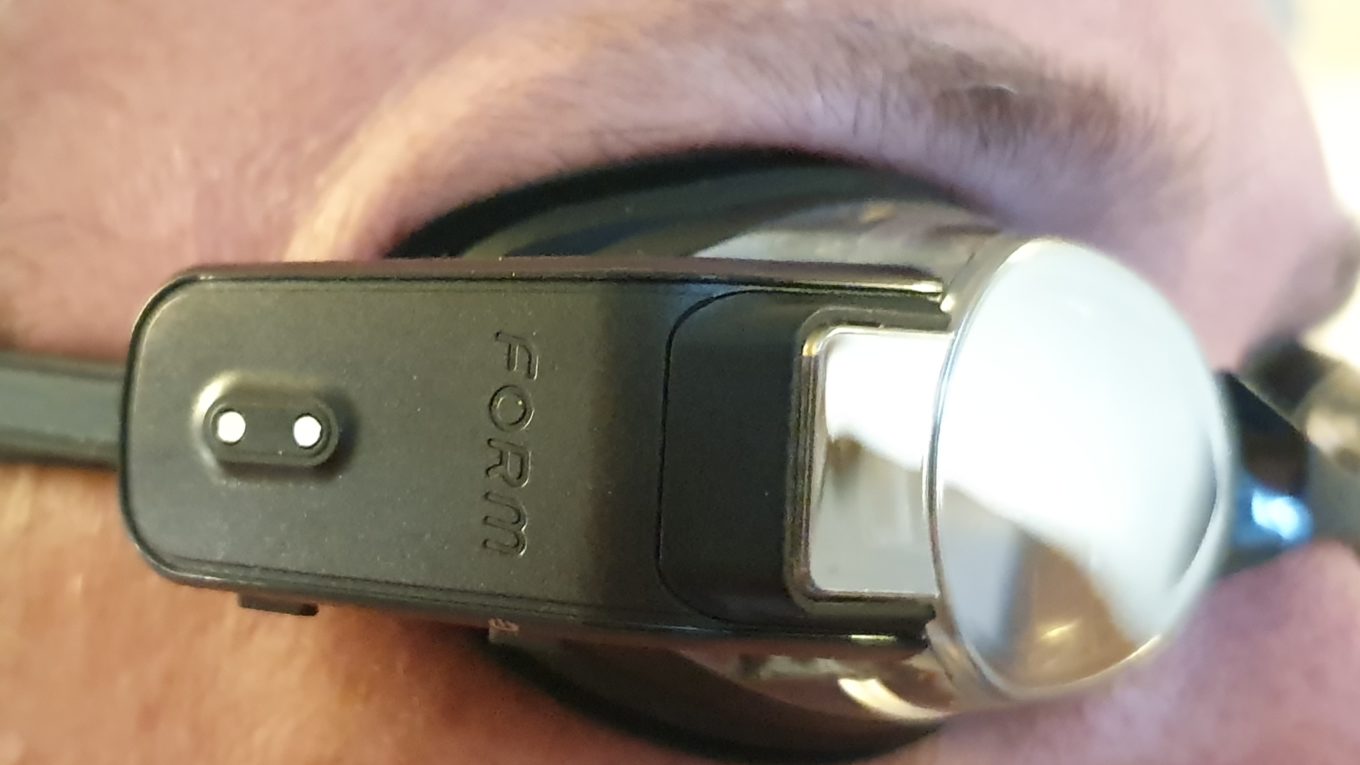Form Swim Goggle review
I find swimming laps in a pool pretty boring. Interval training and drill sets can really help to break things up but I still often find my attention wandering.
‘That guy’s swimming in the wrong lane.’
‘What shall I cook for tea tonight? Sausages?’
‘I wonder if there’s any good movies coming out soon?’
‘Ah-ah, I know what you’re thinking, “Did he swim sixteen lengths or only fourteen?” Well, to tell you the truth, in all this excitement I’ve kind of lost track myself…’
That sort of thing. I’m always losing count. I also lose focus and every now and again have to catch myself and force myself to step the performance a notch or two. It surprises me that in this Strava enabled age although you can get more swim data it’s usually tied up with fiddling with chest straps and watches and most data isn’t available until the swim is finished.
The Form Swim goggles look to change all that, using Augmented Reality to give you a Head Up Display in your goggles. Form are a company run by a long time swimmer who’s been trying to bring augmented reality to sports for over a decade, starting with Recon Instruments. They initially had to focus on ski masks, as the technology then was too large for swim goggles. When Recon was bought, then shuttered by Intel, the team had a chance to start again – and that experience really shows in the finished device.
As part of channel swim training, I’m spending a lot of time in the pool. I’ve been dropping hints to my lovely wife for a while, and was really excited to get a pair as a recent birthday present. Normally I’d be stressing I paid for the hardware with my own money, but in this case it was hers! Win!
This is an important early point; these goggles use an accelerometer – they do not have a GPS built in and so are only really useful for pool swimming, not open water.
Unboxing
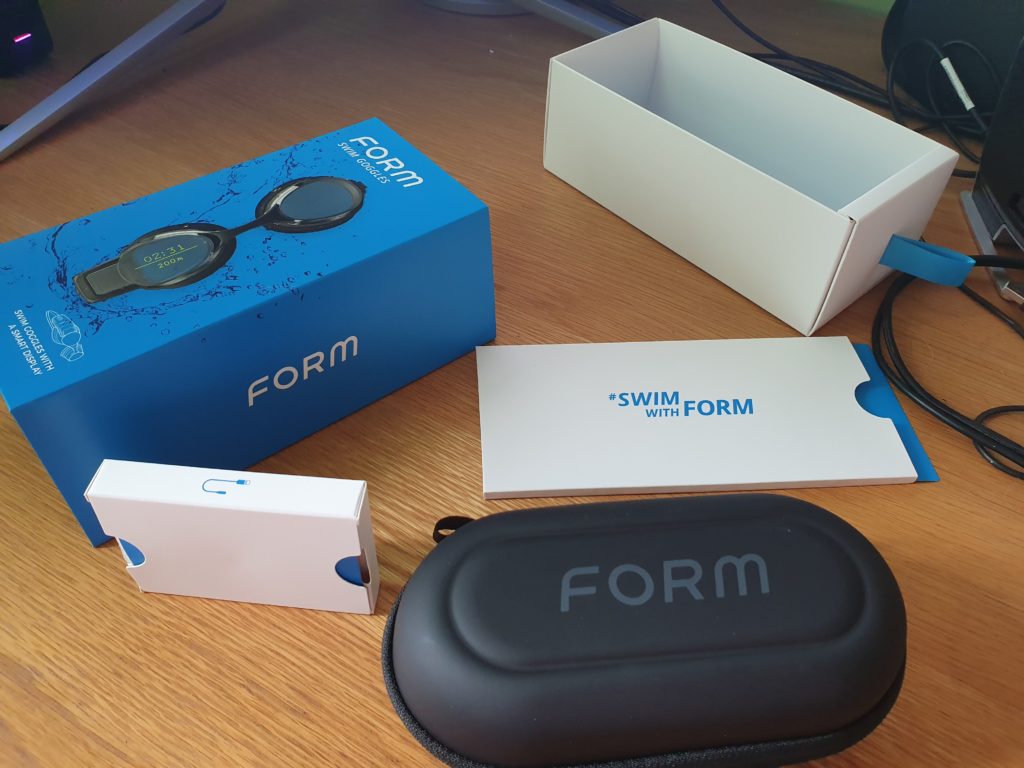
The Form Swim goggles arrive in a smallish box which comfortably meets what seems to be a new standard for clever, smart packaging. Minimal (but adequate) instructions, goggles packed in a protective case with drain holes, five nosepiece size options to maximise fit and a magnetic charging cable to make the waterproofing more durable. It’s all crisp, clean and well thought through.
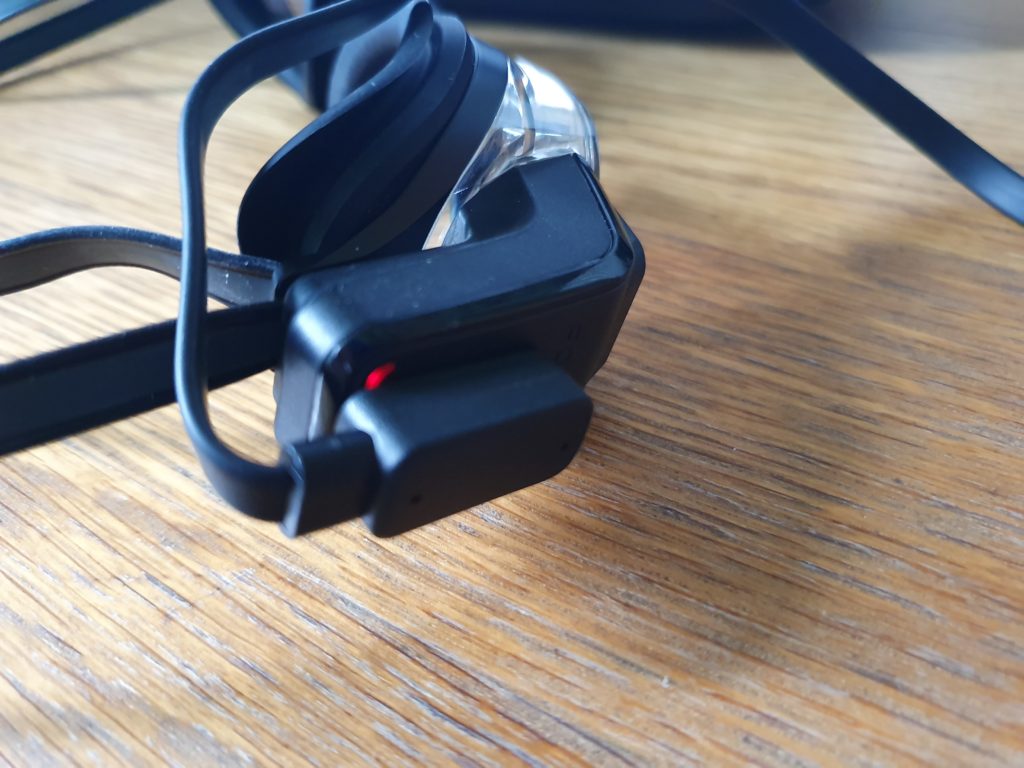
I do seem to be rapidly acquiring proprietary magnetic chargers for all sorts of devices at the moment, I guess it’s too much to hope for a USB-Magnetic standard given all these things are charging from the same USB connection at the other end.
Wearability
Obviously, I was keen to try the goggles on, and the first impression was that the fit was ok. I apparently have large eye sockets and was initially concerned that there was pressure I could feel on my eyeballs that I do not experience with my preferred ordinary goggles (Aquasphere Kayennes), but I can confirm when swimming I soon forgot all about this. By the end of the first session I had reconsidered and would describe them as very comfortable.
Looking at the goggles while on, if someone else knows what they are looking at it’s going to be hard to miss the black box on side containing all the brains (reversible, if you are left/right eyed), but in the pool I don’t think many swimmers are going to notice any difference.
There is one possible exception here – I did feel slightly uncomfortable when using the two buttons on the device to move through menu options at the start and finish of the swim. I can imagine that the most likely assumption anyone would make would be that I was taking photos which could lead to a difficult conversation. I’ll update if I wind up having any issues of this sort.
To be very clear, the goggles are not heavy, are very comfortable and do not seem to impede progress through the water in anyway. If I looked down towards my feet while moving quickly I could feel a slight lift on the lenses, but I don’t need to do that very often and no water got in even when I did.
Visibility through both lenses is the same – there’s no obstruction of the view until the goggles are powered up, where you can quickly step through a simple and intuitive menu to get to the swim set up you need for that session – this is an example of where the design, the software on the device in this instance, is clearly mature.
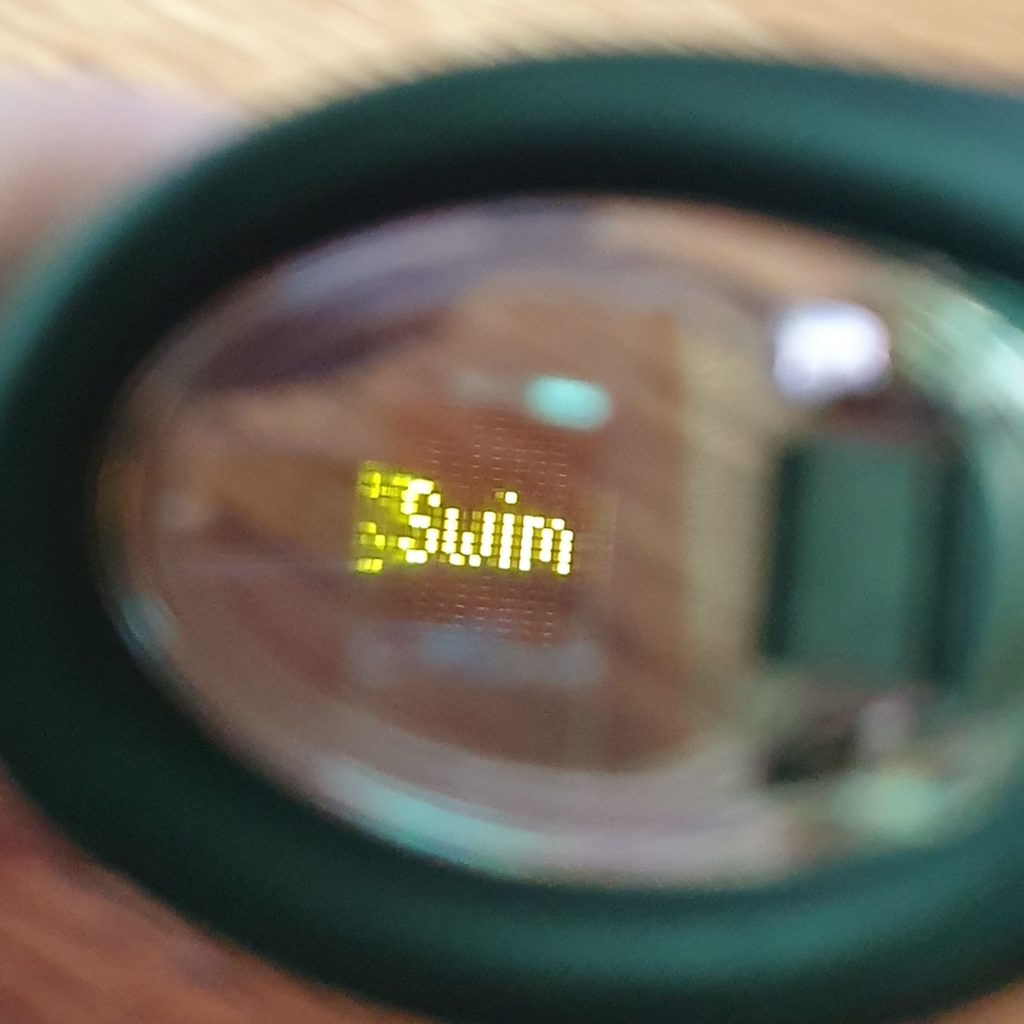
It’s actually hard to get a sharp photo of the text through the lens, but it’s razor sharp with an artificial focus distance some way away from your eye so it’s not hard to see the information while swimming.
When you are in the pool, its amazing how fast the brain adjusts to what’s being shown. I’m pretty good at leaving my lower eye underwater when I breath (usually the right one, which is the side I had the display on) and even in my first swim session I had to check several times that I wasn’t doing something different as my brain ‘spread’ the display from the left side goggle across the center of my view. Its a slightly weird sensation, but again, you get used to it really quickly.
Using the App
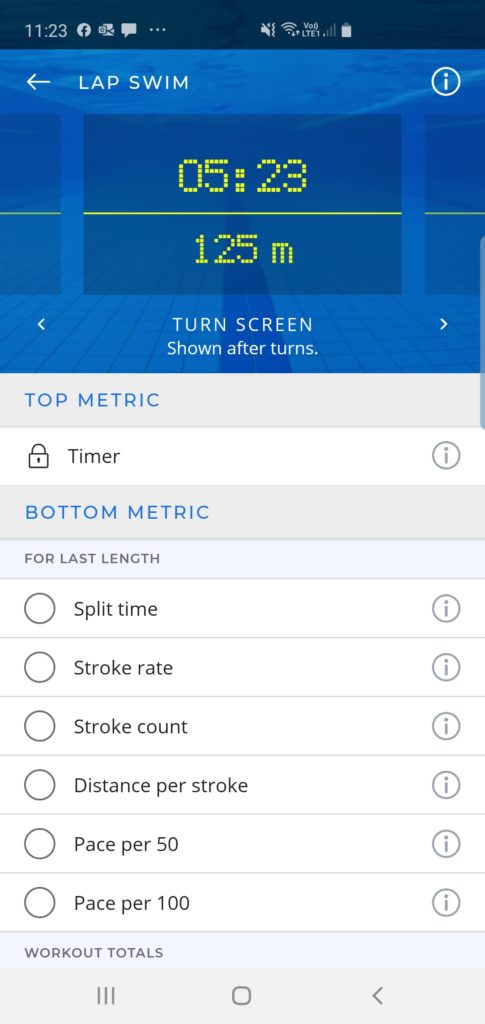
Pairing the goggles to a phone takes a few seconds, then you can quickly customise the display in the app. You can have two fields while swimming (the top one is always a timer, at the moment I have pace/100m in the bottom), a different bottom field for the turn (I have distance, for when I’ve lost count) and a rotating three bottom fields while you rest.
And let me be really clear on this – for me, its interval training where this device really hits home. The Form Swim Goggle automatically keeps track of when you have finished an interval by detecting your rests. This enables all sorts of cleverness; it measures your rest (showing a counter for you) then starts a distance count for the next interval, works out what stroke you are doing for the log later, and gives you a pace specific to that drill, all without the frantic grabbing for multisport watch lap buttons you see happening elsewhere in the pool.
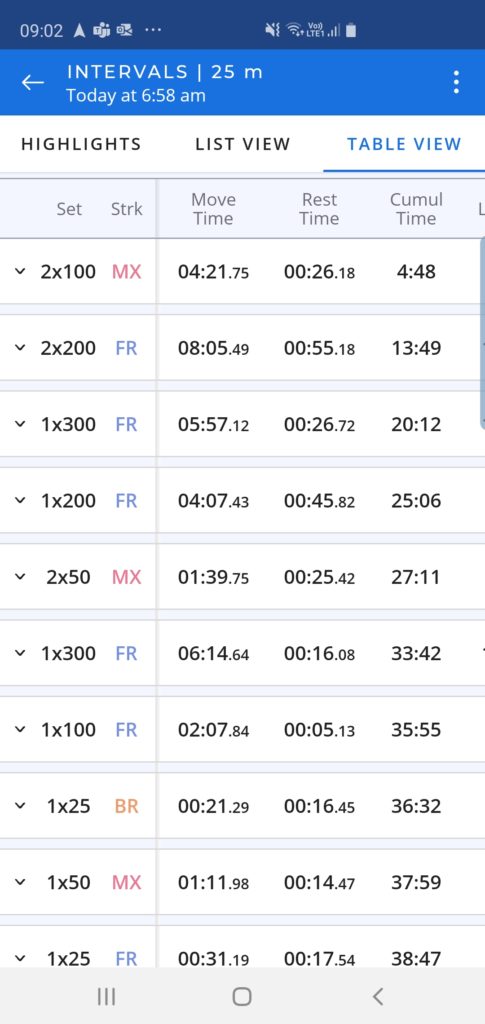
The goggles so far have faultlessly identified every set I’ve swum of crawl, backstroke, breaststroke and mixed sets, but did get horribly confused by some sculling drills, which I’m not totally surprised by.
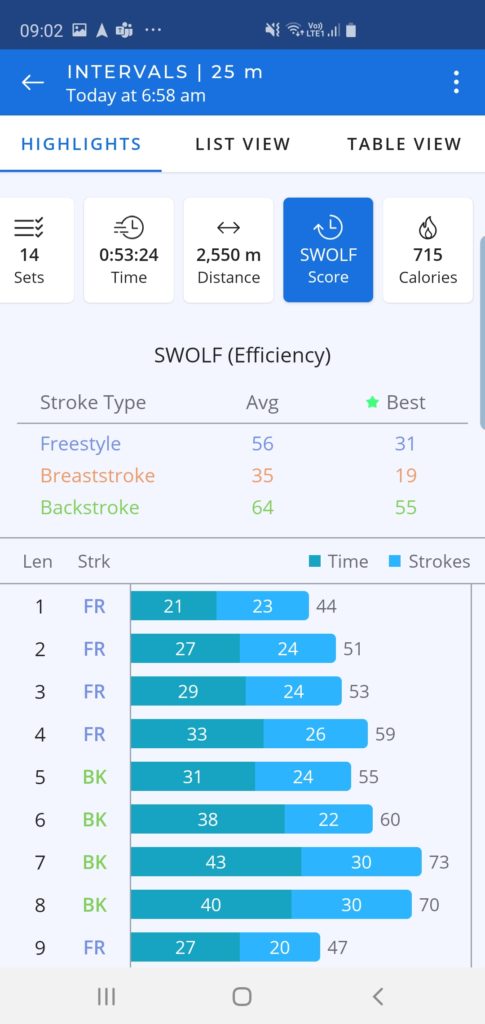
There’s a load of additional data available to you (like SWOLF scores, for example). One thing I’d really want and which is missing right now, is Heart Rate tracking, but this is apparently coming in November – just bear in mind there will be an additional spend on a Polar OH1 sensor and an additional device to charge. On the positive side it’ll give you another black box on the other side of your goggle strap and hopefully even the look out a little!
Conclusions
The goggles do feel durable, but given that I usually scrap a pair of goggles inside of six months, it will be interesting to see how these hold up. I will update when they’ve taken a beating.
Considering the technology in them I think they are actually really reasonably priced at $199 and arrived in a couple of days despite being shipped from (I believe) Canada – the question is, putting the technology to one side do they deliver enough value to make it worth the purchase and to go through the hassle of charging, and syncing and taking more care of them than I would a £15 pair?
For me, the answer is a surprisingly clear yes; they don’t have a negative impact on my swim and the information delivered is really helping me complete my interval sets as planned, and at a more consistent performance level as the instant feedback allows me to adjust what I’m doing mid set.
It’s clear that this is a space where the capabilities are probably going to advance rapidly over the next couple of years, but like the xtrainerz, it’s a useful product now, the technology is actually insanely cool and you don’t really look like anymore of a dork wearing them than an ordinary pair of goggles. I’ll be fascinated to see what I’m using them for in 12 months time as updates add capabilities like the HR tracking.
Basically, they free my imagination to wander a little while I pound up and down the pool and to be able to do that without wrecking the set is priceless on it’s own; if it helps me optimise my performance that’s a significant bonus.

